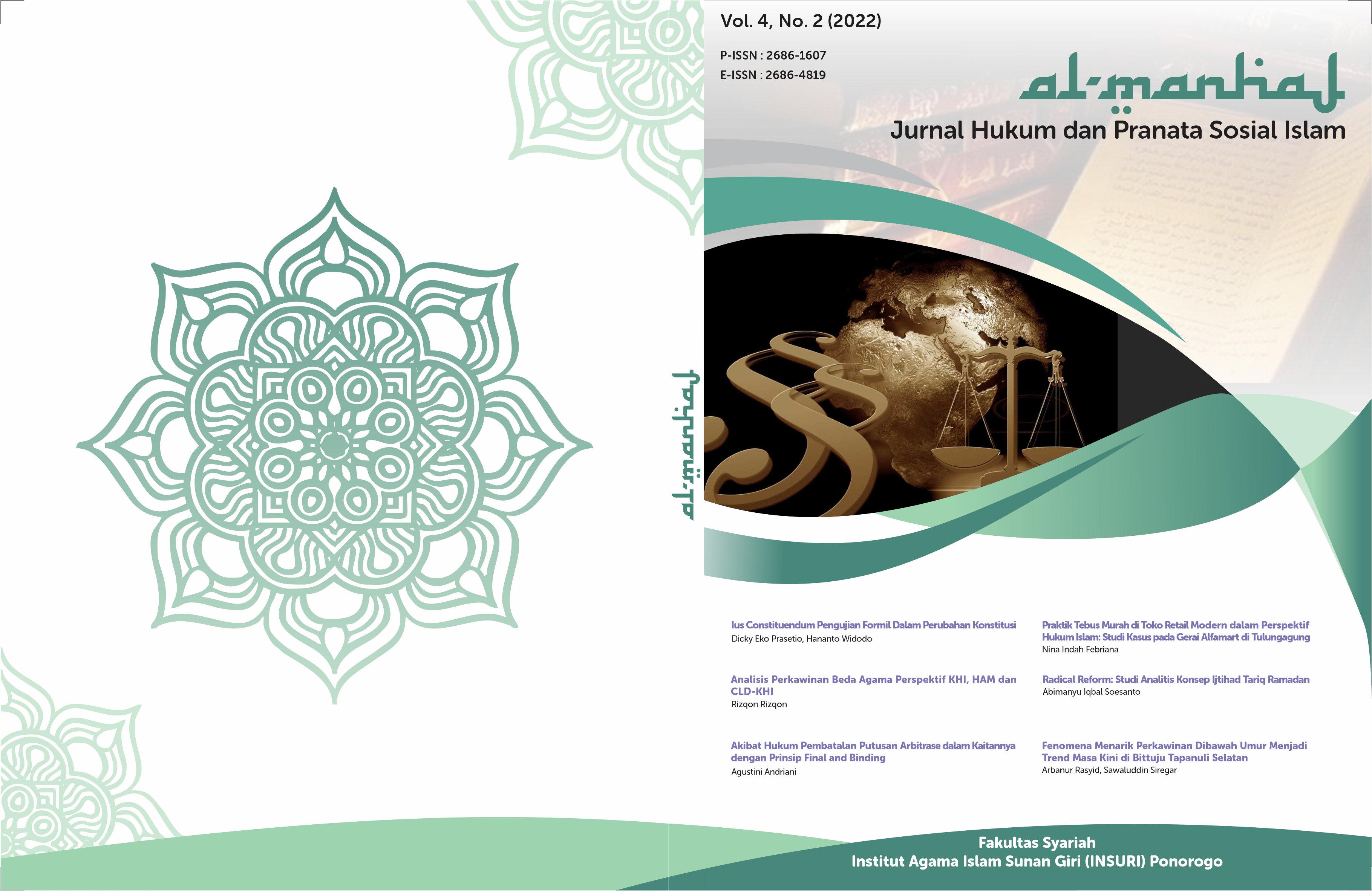Penegakan Hukum Tindak Pidana Kekerasan Dalam Rumah Tangga Diwilayah Hukum Kepolisian Sektor Kuantan Tengah Kabupaten Kuantan Singingi
DOI:
https://doi.org/10.37680/almanhaj.v4i2.1991Keywords:
Law Enforcement; Criminal acts; Domestic violenceAbstract
Law enforcement against criminal acts of domestic violence in the jurisdiction of the Central Kuantan Sector Police takes preventive measures, namely seeking peace or mediation to the parties by providing input and solutions to problematic parties and socializing law number 23 of 2004 concerning the elimination of domestic violence. domestic violence and repressive actions such as investigation, investigation, arrest, detention, search, confiscation, and submission of case files. Inhibiting Factors in Law Enforcement of Domestic Violence in the Police Legal Area of Central Kuantan Sector, namely Legislation Factors, Law Enforcement Factors, Facilities and Infrastructure Factors.
References
Adami Chazawi, S.H.,2001,Pelajaran Hukum Pidana Bagian 1, PT. Raja Grafindo Persada, Jakarta
Andi Hamzah.2001, Bunga Rampai Hukum Pidana dan Acara Pidana. Ghalia Indonesia. Jakarta.
Atmasasmita Romli,1988, Teori dan Kapita Selekta Kriminologi, Eresco, Bandung
Djannah Fathul.2003 Kekerasan Terhadap Istri , Cetakan I, Lkis ,Yogyakarta
Fransiska natalia dkk, 2020, Penegakan Hukum Terhadap Kekerasan Dalam Rumah Tangga Oleh Pihak Istri Di Wilayah Polres Jakarta Barat, Lex Jurnalica vol.17 no.1.
Ilham Bisri, 1998,Sistem Hukum Indonesia, PT. Raja Grafindo Persada, Jakarta
Jack D. Douglas & Frances Chaput Waksler, 2002, Kekerasan dalam Teori-Teori Kekerasan, Ghalia Indonesia, Jakarta.
Jan Remmelink, 2003,Hukum Pidana (Komentar Atas Pasal-Pasal Penting dalam KUHP) Bandung
Lamintang. 1996,Dasar-Dasar Hukum Pidana Indonesia. PT. Citra Adityta Bakti.Bandung.
Leden Marpaung.1992, Proses Penanganan Perkara Pidana, Sinar. Grafika, Jakarta.
Maggie Humm, Dalam Gadis Arivia, ‘Mengapa Perempuan Disiksa?”, Jurnal Perempuan Vol. 1 Agustus / September 1996
Martha, A. E. (2012). Perempuan dan Kekerasan dalam Rumah Tangga di Indonesia dan Malaysia. FH UII Press.
Moeljiatno, 1993, Asas – Asas Hukum Pidana. PT. Bima Aksara. Jakarta.
Moerti Hadiati Soeroso, 2006, Kekerasan dalam Rumah Tangga dalam Perspektif Yuridis- Viktimologis, Sinar Grafika, Jakarta.
Muhammad Farouk, 2003, Menuju Reformasi Polri, Restu Agung, Jakarta
Muladi dan Barda Nawawi Arif, 1992, Teori-teori dan kebijakan pidana, Bandung
Mustofa, Muhammad, 2007, kriminologi, Fisip, UI Press, Jakarta.
Prayudi Guse, 2009, Berbagai Aspek Tindak Pidana Kekerasan Dalam Rumah Tangga , Cetakan II, Merkid Press,Sukabumi
Sadjijono,2010, Memahami hukum Kepolisian, cetakan I,P.T Laksbang Presindo, Yogyakarta.
Sajipto, R. (2008). Hukum Progresif Sebuah Sintesa Hukum Indonesia. Genta Publishing
Saraswati Rika,2006, Perempuan dan Penyelesaian Kekerasan dalam Rumah Tangga, PT. Citra Aditya Bakti, Bandung.
Siti Musdah Mulia, MA., APU,Ketua Tim PUG Departemen Agama RI dan Dosen Pascasarjana UIN Syahid, dalam Blok ICRP, Jakarta 28 Mei 2007
Soejono Soekanto,2011, Faktor-faktor yang mempengaruhi penegakkan hukum, Rajawali Pers,Jakarta,
Soeroso Hardiati Moerti, 2010, Kekerasan Dalam Rumah Tangga Dalam Perspektif Yuridis-Viktimologis , Cetakan pertama, Sinar Grafika Offset ,Jakarta
Topo Santoso,2009, kriminologi, Rajawali Pers, Jakarta
Undang-Undang Dasar 1945
Undang-Undang Nomor 1 Tahun 1946 Tentang Kitab Undang-Undang Hukum Pidana
Undang-Undang Nomor 2 Tahun 2002 Tentang Kepolisian Negara Republik Indonesia
Undang-Undang Nomor 23 Tahun 2004 Tentang Penghapusan Kekerasan Dalam Rumah Tangga
Undang-Undang Nomor 39 Tahun 1999 Tentang Hak Asasi Manusia
Undang-Undang Nomor 8 Tahun 1981 Tentang Kitab Undang-Undang Hukum Acara Pidana
Wiranti, Y. (2017). Upaya Perlindungan Hukum Terhadap Perempuan Melalui Rancangan Undang-Undang Penghapusan Kekerasan Seksual. Legal Smart Channel. https://lsc.bphn.go.id/artikel?id=772
Zastrow, Charles & Bowker, L. (1984). Social Problems: Issues and Solutions. Nelson-Hall
Downloads
Published
How to Cite
Issue
Section
License
Copyright:
- Author retains the copyright and grants the journal the right of first publication of the work simultaneously licensed under a Creative Commons Attribution 4.0 International License that allows others to share the work with an acknowledgment of the work's authorship and initial publication in this journal.
- Author is able to enter into separate, additional contractual arrangements for the non-exclusive distribution of the journal's published version of the work (e.g., post it to an institutional repository or publish it in a book) with the acknowledgment of its initial publication in this journal.
- Author is permitted and encouraged to post his/her work online (e.g., in institutional repositories or on their website) prior to and during the submission process, as it can lead to productive exchanges, as well as earlier and greater citation of the published work (See The Effect of Open Access).
License:
-
Attribution — You must give appropriate credit, provide a link to the license, and indicate if changes were made. You may do so in any reasonable manner, but not in any way that suggests the licensor endorses you or your use.
-
No additional restrictions — You may not apply legal terms or technological measures that legally restrict others from doing anything the license permits.
You are free to:
- Share — copy and redistribute the material in any medium or format
- Adapt — remix, transform, and build upon the material for any purpose, even commercially.

This work is licensed under a Creative Commons Attribution 4.0 International License.














